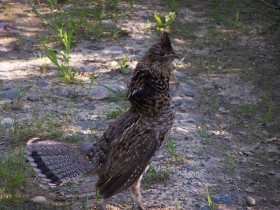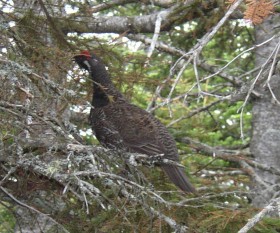Physical Characteristics
Ruffed grouse (or “Partridge”) are the most widely distributed game birds in North America. They rank among the smaller of the 10 species of grouse native to North America with weights ranging from 17 to 25 oz. The subspecies that inhabits Maine is the St. Lawrence or Canada ruffed grouse.
Plumage of the ruffed grouse is subtly and beautifully marked in a way that blends remarkably with their habitat. Conspicuous markings are the broad black band of the fan-like tail feathers and the patch of dark feathers on both sides of the neck that can be expanded umbrella-like into a ruff. There are two color phases of ruffed grouse, red and gray. The gray phase is predominant in Maine.
The Spruce Grouse is also found in Maine. They prefer open coniferous forests and rost in trees. The red eyebrows are a distinctive mark.
Thr Ruffed Grouse of both sexes, and birds that have lost their juvenile plumage, all look alike. The most reliable method of determining sex of a bird is by examining its internal organs. In the field, a rough guess can be made by looking at the relative length of the tail to the body. The female grouse has a tail about as long as her back, whereas the male’s tail appears longer than his back.
Natural History
Habitat. Ruffed grouse occur throughout Maine in hardwood dominated mixed growth, softwood dominated mixed growth, upland hardwoods, lowland hardwoods, old fields, and orchards. Approximately 27,690 square miles of Maine is forest land and is considered grouse habitat, but the quality of the habitat varies widely according to the age and types of forests. Fire can create mixed-age stands of aspen that is considered premier ruffed grouse habitat. Because of the small home range of grouse, good habitat must meet all food, shelter, and drumming requirements within a small area (generally less than 30 acres).
Food habits. Ruffed grouse are omnivorous; they eat green leaves, fruits, and some insects. During winter, when snow covers the ground, they live almost exclusively on the dormant flower buds or catkins of aspens, birches, and cherries. Aspen is generally regarded as the most important single year-round food for ruffed grouse in Maine. Grouse chicks feed on insects, a high protein food that helps them double their weight during their first week of life.
Reproduction. With the onset of spring, male ruffed grouse become aggressively territorial and defend an area of woodland approximately 6-10 acres in size. Male grouse then proceed to “drum” – a territorial display which also serves to advertise their location to females. Females are receptive to, and mate with, displaying males for only a few days. After fertilization occurs, they leave the male and seek nesting cover. Most ruffed grouse nests are located at the base of trees in open hardwood stands, although other sites (such as the base of stumps, under slash, bushes, or brush piles) are commonly used.
The clutch normally numbers 9 – 14 eggs, which are laid over a period of approximately 2 weeks. The eggs are incubated about 24 days, and all the eggs hatch within a few hours of each other during late May and early June. Young ruffed grouse are able to move about shortly after hatching, therefore they are capable of moving to brood range (forest openings created by fire, logging, etc.) after only 3 or 4 days.
Both eggs and brood are vulnerable to predation by foxes, weasels, skunks, raccoons, hawks, owls, and other predators, including dogs and cats. The hen will try to protect the eggs and young by feigning injury (“broken wing act”) or bluffing to draw the predator away. Over a third of the nests may be broken up before the eggs hatched. When the young are about 12 – 14 weeks old, the families begin to break up and a general fall dispersal begins.
Longevity. Few grouse in the wild live beyond 3 years, however, an occasional bird can live to be 7 years of age or older.
Movements. Grouse are generally active during the day, particularly shortly before sunset. They are not active during the night, except drumming males may drum during the night, particularly on moonlit nights. Home ranges of adult females are roughly 30 acres, but becomes smaller during egg-laying, and is smallest when females are incubating eggs. Juvenile females can have home ranges exceeding 100 acres during the winter.
The males territory is roughly 10 acres, depending on the quality of the habitat and proximity to other male territories. Its territory generally consists of a drumming log, fairly thick cover, and a source of food and water. Once established in its territory, a male may never venture more than 600 – 800 feet from its drumming log the rest of its life. Both young males and females can disperse several miles before finding suitable habitat to set up their home ranges.
Historical Management in Maine
Population and distribution trends. Historically, ruffed grouse were present in all parts of Maine, but to a lesser extent in the more wilderness areas. Native Americans often used fire to clear land and possibly to attract grouse. European settlers cleared forest lands for farms, and tales of multitudes of grouse around settler’s clearings are numerous.
Market hunting for grouse became common in the late 1800s and early 1900s. Private farms were numerous in Maine in the late 1800s when over 6.5 million acres of Maine was farmland. By 1980, less than 1.5 million acres remained farmland. Natural succession of the abandoned farms created vast acreage of prime ruffed grouse habitat. This, plus expansion of the pulp and paper industry in Maine, improved habitat conditions for grouse. Today, farmland abandonment has slowed and Maine’s forest has stabilized.
Ruffed grouse are abundant throughout Maine, but their densities vary across the state. The highest densities occur in the transitional zone between the “big woods” and more developed areas of the state. The quality of this area is enhanced by a good interspersion of active and abandoned agricultural land.
Season history. Maine’s grouse were first a source of food for Native Americans and then early settlers. They then became the quarry of market hunters, and now they are the number one game bird in Maine. The first laws to protect grouse in Maine were enacted in 1882, when laws governing market hunting began to be enacted. During the early 1900s, the season was approximately 10 weeks in length with a 15 bird daily bag limit. By 1920, the season had been reduced to 8 weeks with a 5 bird limit. Further reductions in season length occurred in the 1930s to approximately our present-day laws, providing a 6 week season with a daily limit of 4 birds.
Harvest trends/statistics. The earliest records of estimated ruffed grouse harvests were compiled in the mid 1950s. Between 1955 – 1971, the average annual kill was estimated to be 200,000 grouse. Beginning in the early 1970s, data from the Department’s Personal Hunting Report were used to provide yearly estimates of hunting effort and harvests. These data indicate that harvests averaged roughly 335,000 per season through the 1970s.
In 1979, regulations governing grouse seasons began to change. By 1981, the reported harvest of 658,000 grouse was almost double that of the 1970s. In the early 1980s, survey data estimated 100,000 hunters harvested over 500,000 grouse each year. Statewide harvest statistics were not collected annually from 1984 to 1993. In 1993, the Department began monitoring grouse harvest trends by asking moose hunters how many grouse they and their party sighted and harvested while hunting moose.
Additional resources
“Ruffed Grouse.” Matula, George. Wildlife Biologist, Department of Inland Fisheries and Wildlife. Condensed, suplemented, and modified. http://www.maine.gov/ifw/wildlife/species/ruffed_grouse/index.htm (accessed December 10, 2011)
Wildlife Division Research & Management Report. Various Years. Augusta. Maine Department of Inland Fisheries and Wildlife. http://www.mefishwildlife.com



